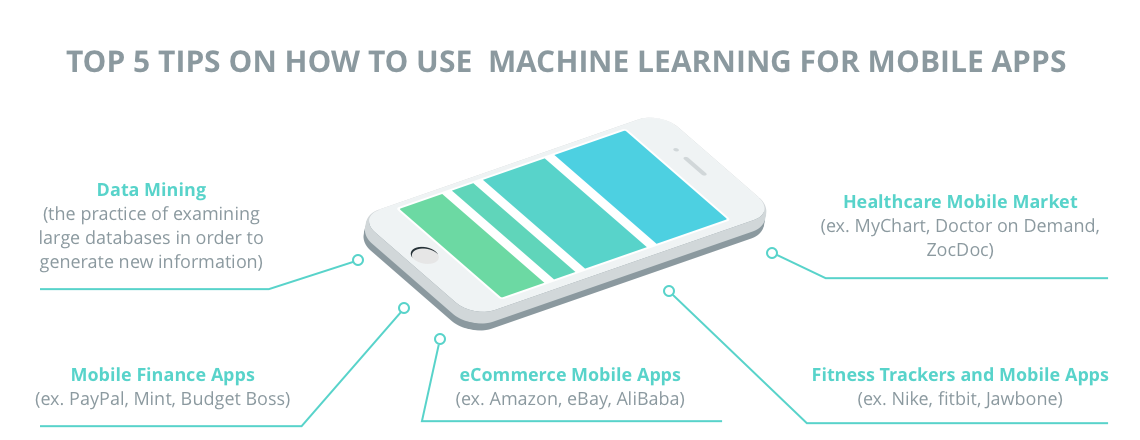What’s Machine Learning & How to Use ML in Mobile App Development
machine learningmobile appstechnologyAs a subfield of artificial intelligence, machine learning keeps changing a growing number of industries. Using algorithms that are constantly learning from data, machine learning allows computers to find such insights as detecting credit card fraud, optimizing manufacturing processes, predicting customer purchase behavior and the personal interests of Web users. It raises the question about how computers might automatically learn from past experiences. Thus, the special data management system uses near-real-time analytics to determine normal behavior, single out anomalies, compare the samples to historical data, and summarize empirical regularities. Due to their high accuracy, these predictions can guide smart actions without human intervention. Machine learning app development has the power of making a mobile app more intelligent. It also means that the tasks are completed without any special programming.
How is ML influencing app development today?
As reported by Venture Scanner, the ML Apps category raises the largest sum in terms of venture funding compared to other artificial intelligence categories, e.g. ML Platforms, Smart Robots, Speech and Video Recognition, etc. Although machine learning has started from the computer, ML apps are evidently even more popular now due to a high productive capacity of modern mobile devices.
The main aim of machine learning, thus, is to make a mobile application as user-friendly as possible. Thereby, one should adhere to the following principles to have the customers’ expectations met:
1. An individual approach is a good thing. It is the simplicity and convenience that each user expects from an application. In fact, any app can using machine learning become a friend to you, the one who is eager to anticipate your wishes and who eventually succeeds in recommending you relevant content.
2. The search is not supposed to be time-consuming and challenging. ML tools may come useful to those who want to find relevant information. These tools analyze a search history and typical actions, provide for spelling correction, voice search and a list of related requests.
3. Customers appreciate optimized e-commerce apps. Luckily, machine learning fits this type of application perfectly. Furthermore, if data on click-through and sell-through rates, search history and purchase patterns are available, a user is more likely to get relevant information. The ML algorithm will simply predict his or her search queries. It allows recommending goods that fit customers’ needs best, namely the best products, offers, channels and sending time.
4. The more types of data you analyze, the more you will learn about the customers’ expectations. Having data about a user available, you increase the chances of getting ML to work for you immensely.

Besides, the popularity of machine learning accounts for the shift in the app development paradigm. Programmers who wrote certain algorithms could rarely be explicit about the expected usage and performance if the output were not apparent from the input. Now, however, systems based on machine learning techniques allow the latter to adjust to the former. It helps to have the relevant data collected, sorted, and stored in the systems to keep learning from these preferences over time and, if necessary, make the adjustments. AI techniques are used to train algorithms and data sets. They boost inference performance as part of machine learning application development. To simplify this procedure, developers should consider the following:
- all available information is to be used for more accurate results
- the machine learning process will be effective if it follows a simple method
- prediction accuracy depends completely on data accuracy
- ML algorithms should always be tested
Mobile ML impact on businesses
The number of smart or artificial intelligence and machine learning applications is constantly growing. Although there are still many apps which are written with a fixed algorithm and do not adjust by the data received, it will change in the nearest future. Users are looking for intuitive and easy ways to satisfy their needs. Fortunately, ML app development implies fetching predictions for apps without execution of custom prediction generation code. AI is not only opening up opportunities for businesses, it also allows them to respond to customers’ inquiries much more quickly, primarily via mobile devices. Market leaders are therefore currently incorporating ML into their products, since the advanced techniques for machine learning app development and ML algorithms, in turn, can adjust the apps to make them personalized.
The most popular mobile applications created with the help of ML
The high productive capacity of mobile devices makes them a perfect fit for highly automated machine learning applications which respond to received queries with predicted results in real time. There are the applications that have once perceived ML as an effective way of having tasks completed and never gone back on the decision:

1. Netflix. People discover the majority of what they watch on Netflix through the recommendation system. It means that ML algorithms make decisions for the users providing them with the content they might not have initially chosen. These recommendations are based on explicit and implicit data. The former is directly concerned with rating, and the latter is the user behavioral data. Besides, Android users now can download content onto a microSD card and store it for 30 days per device, which is also deemed to be explicit data to be used by ML algorithms.

2. Tinder. In 2016, the app introduced machine learning through its Smart Photos feature. It measures the percentage of “likes” associated with showing different combinations of the same photographs to different people. The more the user swipes and the more he or she is swiped on, the better this algorithm, counted for an increase in matches, works.

3. Snapchat filters. The clever facial-tracking algorithm analyzes a gazillion faces to start recognizing a face with all its features. Then, powered by augmented reality technology, it can overlay filters, lenses, and masks properly onto it via the phone's front-facing camera.

4. Oval Money. As personal finance management app for both iOS and Android, Oval allows users to avoid extra spending. It encourages them to improve financial decision making through suggestions and advice of other users creating collective intelligence. Considering spending habits of the users, the app forms a personalized strategy following which people have their deposit made automatically.

5. Google Maps uses machine learning magic to predict parking. Taking advantage of geodata from users for training models, it gauges the parking difficulty. This tool covers 25 cities inside and 25 cities outside the United States now.

6. Dango is an emoji assistant that literally understands you. It is looking through some comments and messages containing emojis and then suggests the perfect ones to be inserted into the text.

7. Uber is increasingly investing in artificial intelligence. The combination of mapping technologies and ML has resulted in Destination Prediction. The app takes into account the rider’s current location, time of the request, and historical information. Thereby, it provides a mobile user with destination suggestions in a context-aware way. For new clients, the service makes suggestions using aggregate data about popular locations.
Conclusion
Machine learning algorithms are a mysterious game changer. However, they do adjust mobile applications to create meaningful and personalized experiences. These apps can also give their users the needed functionality and content driving innovation across every industry. The user and the intelligent system interact with each other primarily to improve the system’s accuracy. Although the machine learning technology is still in its infancy, human-computer collaboration is a promising direction for machine learning systems to work more intelligently. This suggests that companies and developers who are still in doubt should put all doubts to rest, try using ML and see how they can benefit from it.

© 2017, Vilmate LLC




